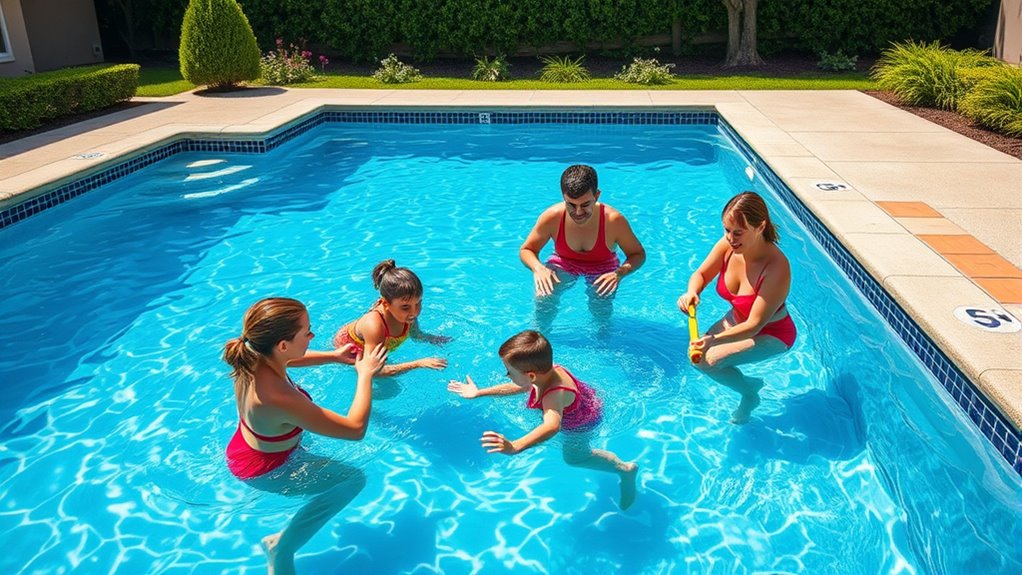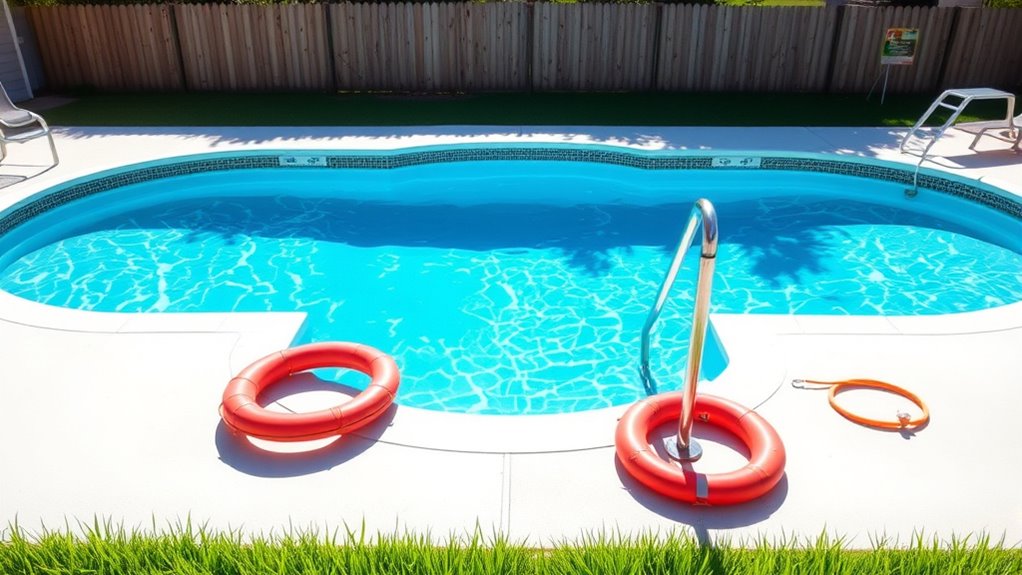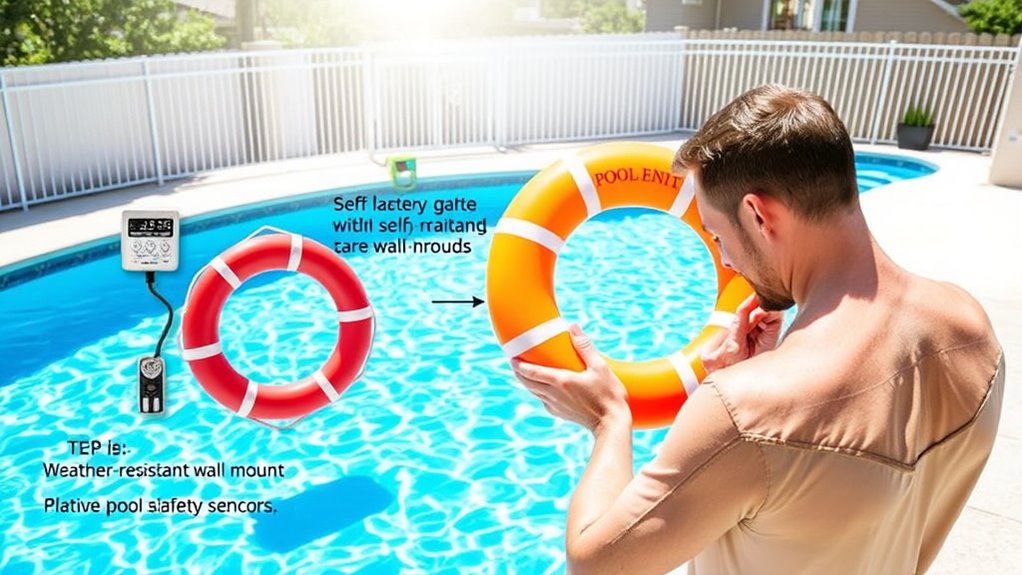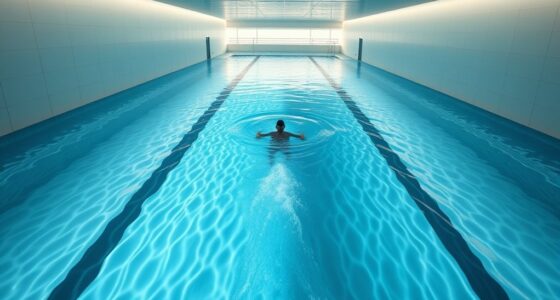To keep your family safe around an endless pool, always supervise children closely and never leave them unattended. Install sturdy safety barriers, alarms, and make sure they’re working properly. Keep the pool area tidy and free of hazards like toys or furniture, and gather all safety equipment nearby. Establish clear rules for pool use and enforce them consistently. Regularly check and maintain safety devices—continuing with these tips helps prevent accidents and keeps everyone secure.
Key Takeaways
- Always supervise children closely, keeping them within arm’s reach and avoiding distractions during pool time.
- Install and regularly inspect safety barriers, alarms, and gates to prevent unauthorized access.
- Keep rescue equipment accessible and practice basic water rescue skills regularly.
- Remove clutter and ensure walkways are slip-resistant to prevent trips and falls around the pool.
- Enforce simple, memorable pool rules and remind family members consistently to promote safe behavior.
Always Supervise Children When They Are in or Near the Pool

Supervising children around the pool is your most important safety measure. Always keep a close eye on kids whenever they’re in or near the water, even if they know how to swim. Distractions can happen easily, so avoid using your phone or engaging in other activities that take your attention away. Assign a dedicated adult to watch children at all times—never rely on other kids or older siblings to supervise. Remember, accidents happen quickly, and drowning can occur silently. Stay within arm’s reach of young children and constantly scan the area. Be proactive in maintaining supervision, making sure no child is left unattended, especially in a busy or crowded pool environment. Your vigilance can prevent tragedies and save lives.
Install and Maintain Proper Safety Barriers and Alarms

Installing and maintaining proper safety barriers and alarms create a vital layer of protection around your pool. Fences at least four feet high with self-closing, self-latching gates prevent children from wandering into the area unsupervised. Regularly inspect these barriers to guarantee they’re intact and secure. Alarms on doors, gates, or windows that lead to the pool area provide an additional alert if someone enters unexpectedly. Test alarms monthly to confirm they work properly, and replace batteries as needed. Keep the pool area locked when not in use, and educate your family about the importance of these safety measures. Incorporating effectiveness of alarms can further enhance safety by providing prompt alerts in case of accidental entry. Combining barriers and alarms markedly reduces the risk of accidental drownings, giving you peace of mind while your loved ones enjoy the pool safely.
Learn and Practice Basic Water Rescue Skills

Practicing water rescue skills regularly helps you respond quickly if someone needs help. Make sure you run supervised drills so everyone knows what to do in an emergency. Keep rescue equipment like life rings and reaching poles ready and accessible at all times.
Supervised Practice Drills
To guarantee everyone knows how to respond in an emergency, it’s essential to conduct supervised practice drills that focus on basic water rescue skills. These drills help your family become confident and quick in action if someone needs help. During practice, assign roles so each person understands their responsibilities, like calling for help or assisting a distressed swimmer. Use a supervised environment to simulate real situations, ensuring everyone practices reaching, throwing, or guiding skills safely. Regular drills reinforce proper techniques and build muscle memory, making responses instinctive. Keep the atmosphere calm and instructive, emphasizing safety at all times. By practicing under supervision, your family will be better prepared to act swiftly and effectively, reducing the risk of accidents turning into emergencies. Incorporating proper safety equipment into your practice can further ensure a safe training environment.
Rescue Equipment Readiness
Having the right rescue equipment on hand is essential for quick and effective water rescues. You should regularly check that all gear is accessible, in good condition, and ready to use. Practice using the equipment so everyone knows how to handle it under pressure. Familiarity can save precious seconds during an emergency. Keep the following supplies nearby:
| Rescue Equipment | Purpose |
|---|---|
| Life Hook | Grab and pull the swimmer |
| Throw Rope | Reach and pull from a distance |
| Buoyancy Device | Support and stabilize the victim |
| First Aid Kit | Treat injuries after rescue |
Ensure all family members understand how to use each item and practice drills periodically to stay prepared. Additionally, understanding the importance of contrast ratio and other technical factors can help in assessing the safety and visibility of rescue signals during emergencies.
Keep Pool Area Clear of Hazards and Clutter

To keep everyone safe, regularly remove obstacles from the pool area and store equipment properly. Make sure walkways are clear of toys and clutter to prevent tripping hazards. By staying organized, you create a safer environment for all swimmers. Additionally, consider using fire pit accessories to enhance outdoor safety and ambiance during evening pool gatherings.
Remove Obstructions Regularly
Keeping the pool area free of hazards and clutter is essential for safety. Regularly remove obstructions to prevent accidents and ensure a clear environment for everyone. Check the deck for toys, furniture, or equipment that could cause trips or falls. Clear away leaves, sticks, or debris that can make the surface slippery. Make sure pool accessories are stored properly and not left scattered around. Keep walkways free of hoses, cords, or other objects that could create tripping hazards. Maintaining a tidy space not only reduces risks but also creates a more inviting and enjoyable swimming environment for your family and guests. Staying vigilant with regular cleaning and organization helps keep everyone safe and the pool area ready for use. Incorporating sustainable storage solutions can also help reduce clutter and promote eco-friendly practices around your pool area.
Store Equipment Safely
Storing pool equipment properly is essential for maintaining a safe and clutter-free environment. When you put away toys, floats, and cleaning tools after use, you reduce the risk of tripping or falling. Use designated storage bins or shelves to keep equipment organized and out of walkways. Make sure pool covers, hoses, and other accessories are stored securely so they don’t become hazards. Avoid leaving sharp or heavy items near the pool area that could cause injury. Regularly check that equipment is stored in a way that doesn’t block access points or emergency exits. By keeping everything stored safely and out of the way, you create a safer environment for everyone and minimize accidents around your pool.
Keep Walkways Clear
Ensuring walkways are clear around your pool prevents accidents and keeps the area safe for everyone. A cluttered path increases the risk of slips, trips, and falls, especially when wet. Keep walkways free of toys, furniture, and equipment to avoid obstacles that could cause injuries. Regularly check the area for any debris or objects that could be tripped over. Use non-slip mats or textured surfaces to enhance safety. Remember, a tidy poolside encourages responsible behavior and quick access in emergencies. Incorporating proper walkway safety measures, such as clear paths and slip-resistant surfaces, can further reduce hazards.
Use Appropriate Safety Equipment, Such as Life Rings and Poles

Using appropriate safety equipment like life rings and poles is essential for preventing accidents and guaranteeing quick rescue if someone struggles in the water. Keep these tools within easy reach and regularly check they’re in good condition. A well-placed life ring can save someone’s life, while a pole allows you to reach and assist without risking your safety. To help you visualize, here’s a quick overview:
| Safety Equipment | Purpose |
|---|---|
| Life Rings | Provide buoyancy and aid in rescue |
| Rescue Poles | Extend reach and pull trapped swimmers |
Having these items ready means you’re prepared for emergencies, reducing panic and response time. Always ensure everyone in your family knows where these safety devices are located and how to use them effectively. Practical safety tips can help you further prepare for unexpected situations.
Establish and Enforce Pool Rules for All Family Members

Setting clear pool rules for all family members is essential to maintaining a safe swimming environment. When everyone understands what’s expected, accidents decrease, and fun remains safe. You should establish rules such as no running around the pool area to prevent slips, always supervising children when they’re in or near the water, avoiding diving in shallow areas to prevent injuries, and not swimming alone to ensure help is available if needed. Clearly communicate these rules and post them visibly near the pool. Enforce them consistently, and remind family members of safety guidelines regularly. Making rules simple and easy to remember encourages adherence. When everyone follows these guidelines, you create a safer, more enjoyable swimming experience for the whole family. Additionally, choosing a memorable and preppy dog name can help foster a sense of responsibility and companionship during pool time.
Regularly Inspect and Maintain Pool Safety Devices and Equipment

Regularly inspecting and maintaining your pool safety devices and equipment is essential for preventing accidents and ensuring they function properly when needed. Check your safety covers, alarms, and barriers weekly for signs of wear, tears, or damage. Test pool alarms and gate latches to confirm they activate correctly and respond promptly. Replace or repair any broken or malfunctioning devices immediately. Keep rescue equipment, like life rings and reaching poles, in accessible, visible locations, and ensure they are in good condition. Clean and maintain your filtration system to prevent debris buildup that could compromise safety. Staying proactive with inspections helps catch issues early, giving you peace of mind that your pool remains a safe environment for your family.
Frequently Asked Questions
How Can I Teach My Children Water Safety Effectively?
You can teach your children water safety effectively by setting clear rules and practicing them consistently. Always supervise them when they’re near water, and enroll them in age-appropriate swimming lessons. Use safety gear like life jackets, and teach them to recognize dangers like rough water or exhaustion. Reinforce safety concepts regularly through fun activities and discussions, so they understand the importance of respecting water and staying cautious at all times.
What Are the Best Ways to Prevent Accidental Pool Entries?
Preventing accidental pool entries is like locking the door to keep intruders out. You should install a secure fence around your pool, use self-closing, self-latching gates, and keep the pool area locked when not in use. Always supervise children closely and teach them to respect boundaries. Cover the pool with a safety cover when it’s not in use, and never leave toys or floats near the edge that might tempt kids to enter unsupervised.
How Often Should Safety Equipment Be Replaced or Updated?
You should replace or update safety equipment at least once a year, or more often if it shows signs of wear or damage. Regularly inspect items like life vests, pool covers, and safety alarms to guarantee they function correctly. Keep an eye out for fading, tears, or malfunctioning parts, and promptly replace or repair them. Staying proactive helps keep your family safe and ensures safety devices work when you need them most.
Are There Specific Safety Tips for Swimming With Pets?
Think of swimming with your pets as dancing in a delicate ballet. Always supervise them closely, never leave them unattended in or near the water. Use a pet-specific life jacket if needed, and keep the pool area secure to prevent accidental falls. Teach your pets to exit the pool safely, and dry them thoroughly afterward. Remember, gentle guidance and vigilance help keep this dance safe and enjoyable for everyone.
What Should I Do in Case of a Pool Emergency?
In a pool emergency, stay calm and act quickly. Remove yourself or others from the water if possible, and call 911 immediately. If someone is drowning, support their head and try to get them out without putting yourself at risk. Use a reaching or throwing assist, like a pole or floatation device, to help. Always keep emergency numbers handy, and practice safety drills regularly with your family.
Conclusion
By following these safety tips, your pool becomes a fortress of protection, shielding your loved ones from harm. Think of it as tending a delicate garden—you must nurture, inspect, and enforce rules to keep it thriving. With vigilance and care, you transform your pool area into a safe oasis where fun and safety grow hand in hand. Stay attentive and proactive; your family’s well-being depends on it.










